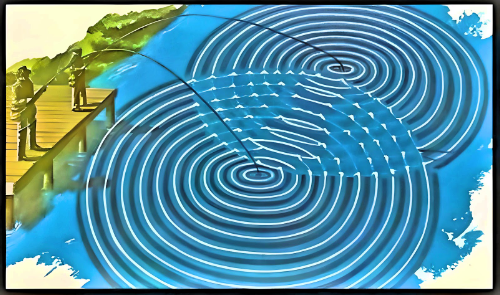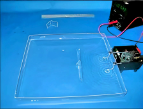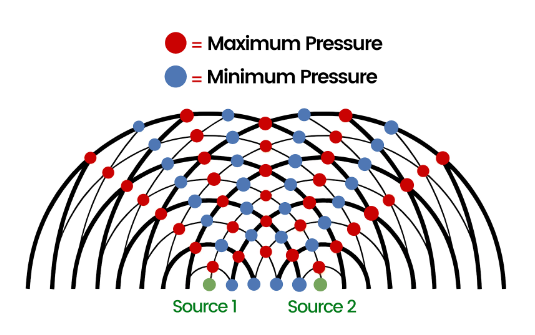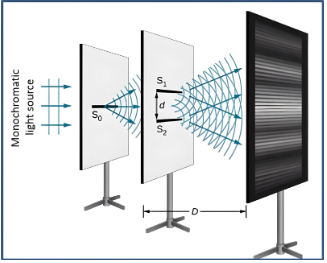Interference
Introduction
The occurrence of interference is attributed to waves when two or more of them collide. The phenomenon of interference is intrinsic to waves, and this article aims to expound on how it transpires across various wave types.

A. Interference
When two or more waves overlap, their combined displacement is equal to the sum of their individual displacements. Displacement is a vector quantity, and the overlapping waves are deemed to interfere, hence the term interference.
This phenomenon can produce a resultant wave with either a larger or a smaller displacement than that of the individual component waves. Figure 2 illustrates a ripple tank, which is used to demonstrate interference through the use of two-point sources.

Figure 2 depicts the interference between two circular waves. When two waves arrive in phase, meaning their crests coincide, they interfere constructively, creating a resultant wave with higher crests and deeper troughs compared to the individual waves.
Conversely, when the two waves arrive in antiphase, with a phase difference of π radians or 180°, the peaks of one wave coincide with the troughs of the other, resulting in destructive interference and a smaller amplitude of the resultant wave.Figure 3 shows the interference pattern between two circular waves. The path difference, which is the difference in travel distance of the two sets of waves, can produce this phase difference.

B. The Phenomenon of Sound Wave Interference
The interference of sound waves can occur when two or more waves with the same frequency collide, which are referred to as coherent waves due to their constant phase difference.
For instance, if two loudspeakers connected to the same signal generator and amplifier emit a note of the same frequency, sound waves’ constructive interference creates louder sound in certain areas around the speakers. Conversely, in regions where the waves interfere destructively, the note is much quieter than in other areas of the pattern.
C. The Phenomenon of Light Wave Interference
In an experiment, Thomas Young provided evidence of how light waves can produce an interference pattern. A monochromatic light source, which emits light of a single color or wavelength (λ), is positioned behind a narrow single slit to generate a well-defined source of light. As the light passes through the slit (S0), it diffracts and gives rise to two sources of light at the double slit (S1 and S2). These two sources of light, being coherent as they originate from the same primary source, create a persistent and observable interference pattern consisting of alternating bright and dark fringes on the screen. This experiment is known as Young’s double-slit experiment, as illustrated in Figure 4.

The spacing between adjacent bright fringes observed on the screen is referred to as the fringe width, and it is proportional to the wavelength λ of the light source. The following equation can be used to calculate the fringe width:

Where,
λ – the wavelength of the light source in meters (m).
D – the distance between the screen and the double slit in meters (m).
d – the distance between the centers of the two slits S1 and S2 in meters (m).
D. Summary
- When two waves overlap, they interfere, which is referred to as interference.
- Waves that arrive in phase, meaning their crests arrive at the same time, will undergo constructive interference.
- Waves that arrive in antiphase, with a phase difference of π radians or 180°, will interfere destructively, with the peaks of one wave coinciding with the troughs of the other.
- The difference in the distance traveled by two waves is known as the path difference.
- Coherent waves are waves with the same frequency and a constant phase difference between them.
- Monochromatic light is composed of a single color and, as a result, has a single wavelength.
- Young’s double-slit experiment is a technique used to investigate the interference of light waves.
In Young’s double-slit experiment, the spacing between adjacent bright fringes on the screen is known as the fringe width, and it can be calculated using the formula (λD) / d.
Interference refers to the phenomenon that occurs when two or more waves meet and combine to form a new wave. This can result in either constructive interference (where the waves add up and become larger) or destructive interference (where the waves cancel each other out).
Some examples of interference in A-Level Physics include double-slit experiments, diffraction patterns, and the interference of sound waves.
Interference can cause light waves to either reinforce each other (constructive interference) or cancel each other out (destructive interference). This can lead to the formation of bright and dark fringes in patterns such as the double-slit experiment.
Interference is a result of the wave nature of light and other forms of electromagnetic radiation. Waves exhibit properties such as wavelength, frequency, and amplitude, which can affect the way they interfere with each other.
The double-slit experiment is a classic demonstration of interference in which light passes through two narrow slits and creates an interference pattern on a screen behind them. This experiment provides evidence for the wave nature of light.
Interference can cause sound waves to either reinforce each other (constructive interference) or cancel each other out (destructive interference). This can lead to effects such as beats in music and the amplification of sound in certain environments.
Interference is used in a variety of real-world applications, such as in radio and television broadcasting, medical imaging, and the design of acoustic spaces. It is also used in the development of technologies such as holography and interferometry.
Some tips for understanding interference in A-Level Physics include practicing with sample problems and experimental setups, studying the underlying wave properties involved, and exploring the various real-world applications of interference. It can also be helpful to work with a tutor or study group to discuss and clarify concepts.





Still got a question? Leave a comment
Leave a comment